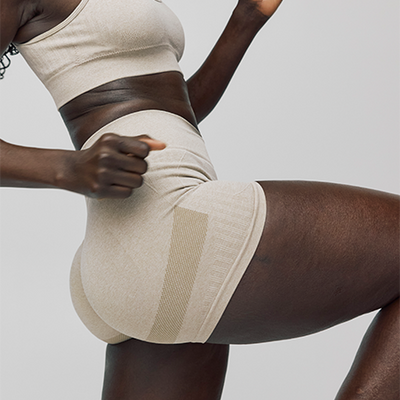
In this article /

We often don’t acknowledge all that goes on in our vaginas, for our reproductive health and daily comfort. The vaginal canal is full of important muscles—these are pelvic floor muscles. Many people face challenges when first using a menstrual cup, especially if you discover that you’re trying to use a menstrual cup with weak pelvic floor muscles. In these instances, there is lots we can learn from experts.
Keri Martin Vrbanac is a Registered Pelvic Floor Physiotherapist. Her mission is to support people with their pelvic health and she is a strong advocate of the DivaCup. We sat down with Keri to discuss some common scenarios our Consumer Experience Team encounters.
Whether you’re a new user, a long-time user, or your body has changed over the years, finding success with the DivaCup can take some time. It may be that the vaginal muscles (the muscles that hold the DivaCup in place) require additional support and conditioning.
Below are example scenarios of what our Consumer Experience Team might receive, as well as Keri’s advice. The human body is unique, however, and while Keri is able to provide some insight, the best results are achieved by working with a registered professional on your own.
Menstrual Cups & a Weak Pelvic Floor
Scenario One:
“I’m a 19 year-old runner and a yoga enthusiast. I recently decided to invest in the DivaCup. I purchased the Model 1 as I’m under 30 years old and haven’t had children. Unfortunately, my experience thus far has not been great. I’m having a really hard time with insertion and rotation. It almost feels as if the cup is too big for me.”
Keri: It’s possible that your pelvic floor muscles are hypertonic, or in other words, too tight. Some women with hypertonic pelvic floor muscles may experience pain when using internal menstrual products or may experience pain with intercourse. The only way to know the status of your pelvic floor muscles for sure is to visit a pelvic floor physiotherapist for a complete assessment. If it turns out that these muscles are too tight, your therapist will educate you on how to remedy the problem to make use of a menstrual cup easier for you.
Scenario Two:
“I used the DivaCup for 6 years before I got pregnant. Fast forward a year and a half after the birth of my child, my period has returned and I’m eager to get back to my DivaCup. I’m 33 years-old and I’m using the Model 2. My cup doesn’t stay in place very well. I am also experiencing leaking, something I never had an issue with before. I used the Model 1 for a number of years and then switched to the Model 2 when I turned 30. Could it be that I need the smaller size again?”
Keri: It’s possible that your pelvic floor muscles have become weaker following your pregnancy/delivery process and are no longer able to hold your cup in place. Finding a menstrual cup for weak pelvic floor muscles unfortunately isn’t the solution. Instead, it’s possible to strengthen the pelvic floor muscles through exercises. Before you begin any form of pelvic floor muscle exercises though, I always recommend visiting a pelvic floor physiotherapist to determine if your pelvic floor is tight or weak, or both. Kegels are not for everyone and in some cases can actually cause more harm than good so consulting with a specialist before incorporating these kinds of exercises is important.
Scenario Three:
“I am 38, have never been pregnant, and am using the Model 2. The cup is easy to insert and rotate, but after a few hours, I can feel it move up. Around the same time, I experience leaks. I’m sure I am inserting the cup correctly, but when it moves up it also makes it difficult to remove.”
Keri: Your pelvic floor muscles may be hypertonic (tight). Trying the smaller size cup may help, but it may be that your muscles need to be elongated or relaxed. Sometimes a smaller pelvis can also affect the tone of the musculature. The only way to know the status of your pelvic floor muscles is to visit a pelvic floor physiotherapist for an assessment.
Scenario Four:
“I’m 26 years-old, have never been pregnant, and am using the DivaCup Model 1. The DivaCup is amazing! As a nurse, I can go an entire shift without worrying about leaks. While sleeping, however, it seems as though the cup shifts down and begins to leak. Do I need a Model 2 to stop it from sliding down? Why is it that it fits fine during the day, even on my heaviest days, and then not at night?”
Keri: Just like the rest of the muscles in our body, the pelvic floor muscles relax when we are resting. They’re not required to work as hard when we are lying down, sleeping because we don’t require as much support as we do when we’re up and moving around. Position changes throughout the night, however, may cause a shift in the position of the cup as well. Supported sleeping with a pillow between your knees may help maintain a consistent and restful position, and prevent leaks from occurring.

Scenario Five:
“As a gym enthusiast, I love lifting weights. I also love the DivaCup—except when it leaks! I find that when I am strength training with heavy weights, the cup moves out of place and I experience leaks, almost as if the seal has been broken. Could my muscles be tensing up so much that they are breaking the seal?”
Keri: This could actually mean one of two things; your pelvic floor muscles could be tight or they could also be on the weaker side. With weight lifting, we increase our intra-abdominal pressure. This in turn causes a downward pressure on our pelvic floor muscles. A pelvic floor physiotherapist can determine the status of your pelvic floor musculature and tailor a program to address to your needs. They can also provide you with tips for safe exercises right now and a program for maintaining your pelvic health into the future. Using a menstrual cup for weak pelvic floor muscles can be a challenge—but one you can overcome.
If you’re struggling with DivaCup insertion or removal, don’t hesitate to reach out to our Consumer Experience Team for TMI-friendly troubleshooting and advice. They can assist you with any issues pertaining to positioning and sizing.
















